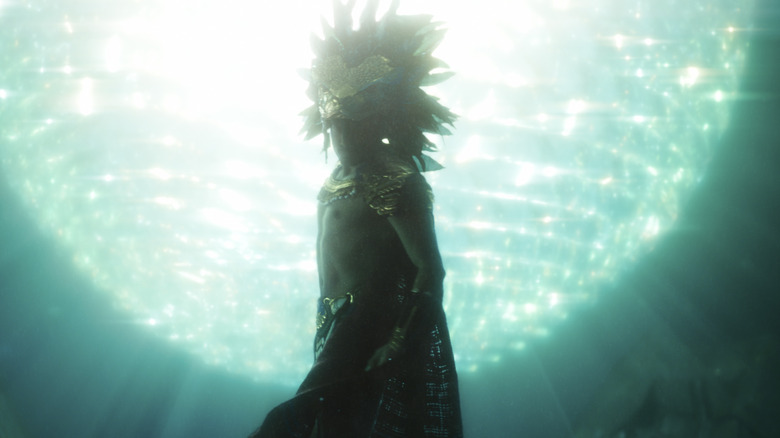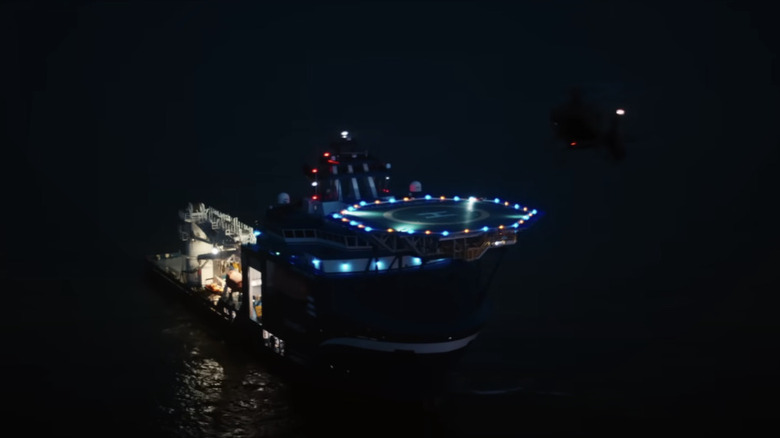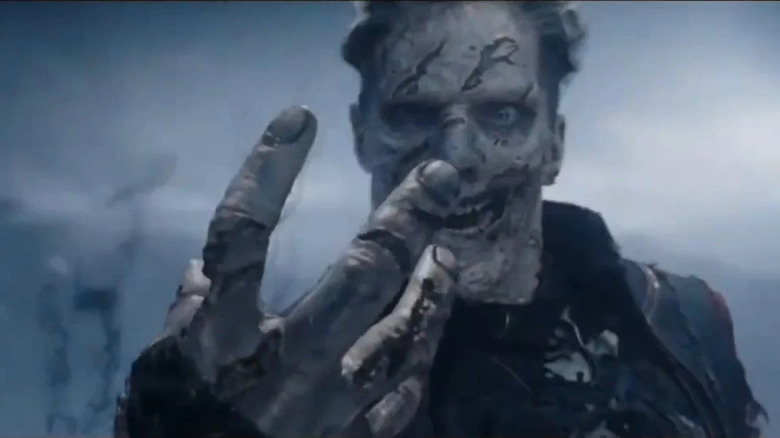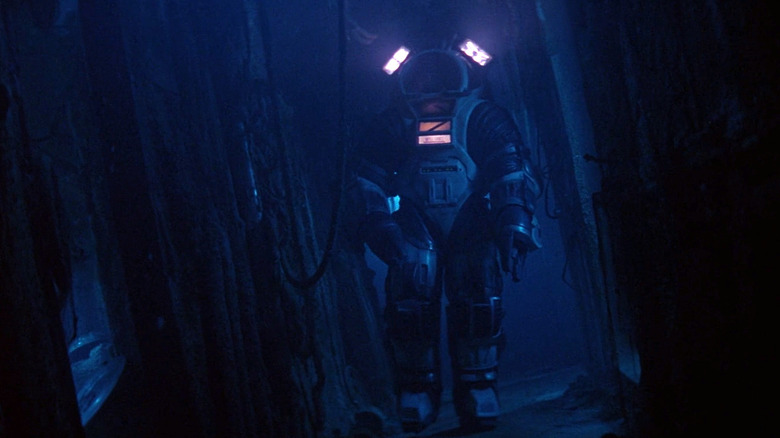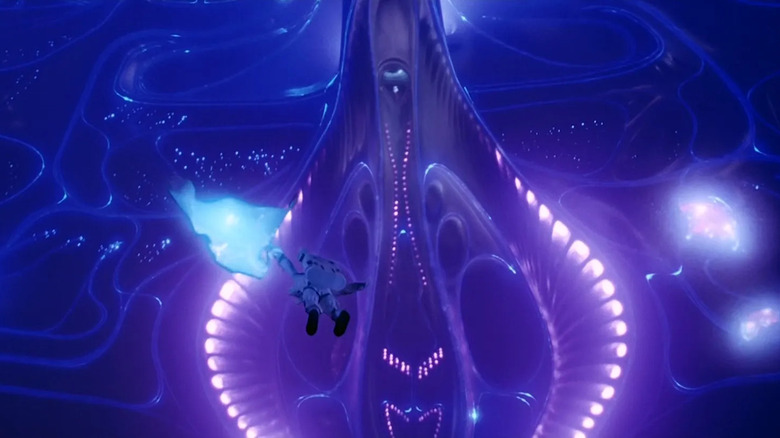One Of The Coolest Scenes In Black Panther Wakanda Forever Recalls Great Aquatic Horror
The expectations for "Black Panther: Wakanda Forever" have been massive ever since the first "Black Panther" was such a huge hit in 2018. With the tragic passing of Chadwick Boseman as well as the pressures created by the pandemic and the generally unexpected vibes of the Marvel Cinematic Universe's "Phase 4" so far, those expectations only got bigger and wilder.
As it turns out, "Black Panther: Wakanda Forever" is a remarkably heartfelt and introspective blockbuster film, a movie that honors its predecessor while furthering the characters as any great sequel should. While there are a lot of surprises to be had in the film, one aspect that was probably not on anyone's "Wakanda Forever" bingo card was that an early setpiece would double as a mini-horror movie. It's a sequence that recalls not just any type of horror movie, but specifically, those that take place deep beneath the ocean.
Deep rising
In the film, Wakanda is a nation that has traditionally been known as the only source of the most powerful (and rare) element in the world, vibranium. After Queen Ramonda (Angela Bassett) doubles down on her refusal to allow anyone outside Wakanda access to that resource, the other nations of the world go searching on their own to see if any vibranium exists elsewhere. Thanks to an assist from tech genius Riri Williams (Dominique Thorne), the USA discovers that some vibranium exists far below the surface of the sea.
Sending an expedition out to this source on a ship equipped with the latest and greatest in diving and mining technology, the Americans begin to study and collect the Vibranium they find as the project head Dr. Graham (Lake Bell) supervises late one night. However, as the divers in the ocean are suddenly attacked by some creatures (or people? Or both?), the crew on deck begin willfully walking off the ship to their death, apparently lured by a mysterious song sung by something out in the ocean.
It turns out that the people responsible for this attack are the Talokan, a nation of enhanced humans who have lived deep beneath the sea for thousands of years. As Dr. Graham loses control of the situation and attempts to leave by helicopter, she's stopped by the leader of the Talokan, a man with mutant powers named Namor (Tenoch Huerta Mejía). His attack on her chopper is even more brutal, shocking, and ominous than that of his brethren.
The MCU continues to prove its horror bonafides
Throughout the sequence of the Talokan attacking the American mining ship, director Ryan Coogler proves he's as adept at crafting a creepy, suspenseful horror sequence as he is helming superhero battles or heartfelt drama. The tension is palpable as each facet of the Talokan are revealed, from their ferocity in battle to their ability to hypnotize their prey to Namor's powers of flight and super-strength.
The sequence is far from Marvel's first foray into horror material, however. While the odd spooky moment or two turned up in the MCU prior to Phase 4, it was within Phase 4 that the universe really began to embrace the horror genre. Shows like "WandaVision" and "What If...?" introduced witches and zombies into the universe, respectively, while Michael Giacchino's recent "Werewolf By Night" short pays homage to classic Universal Monsters horror.
Arguably the biggest step into horror taken by the MCU so far is "Doctor Strange and the Multiverse of Madness," directed by none other than Sam Raimi of "The Evil Dead" and "Drag Me To Hell" fame. Thanks to Raimi moving the superhero horror goalposts with his film, as it were, Coogler and "Wakanda Forever" are able to pick up that baton and run with it.
Terror from the deep
When most people think of horror films set in or around the ocean, they tend to think of "Jaws" and its ilk. Although the initial Talokan attack in "Wakanda Forever" seems to involve an undersea beastie or two — later in the film, the Talokan ride into battle on giant humpback whales, for instance — the sequence is far more reminiscent of more existential and supernatural undersea horror.
The moment when two divers in exosuits get near the vibranium deposit only to be attacked by something unseen recalls a similar sequence from 1989's "Leviathan," where the danger is both from the external threat as well as the millions of gallons of water surrounding the characters. "Leviathan" concerns a group of deep-sea explorers encountering an otherworldly threat, as does "Deep Star Six," also from 1989, another film that exploits the fear of a powerful threat combined with the claustrophobia of being deep underwater.
The Talokan's eerie calm when luring the crew of the mining ship to their doom feels downright Lovecraftian in its effect — it's not a stretch to imagine the evil worshippers from 2001's Lovecraft-based "Dagon" having such power at their disposal. "Wakanda Forever" is the latest to exploit these threads of underwater horror, but a recent film that ties them all together is 2020's "Underwater," something worth checking out if you enjoy the "Black Panther" sequence.
Beneath the surface lies the future
Of course, as "Wakanda Forever" continues, it's revealed that there are more sides to the Talokan than just fear and violence, as they are an ancient people who have been abused horribly in the past and are looking to ensure their survival. The tale of an undersea species with great powers who at first appear terrifying and then are proven more multi-faceted heavily recalls James Cameron's 1989 opus "The Abyss," a movie that, as "Wakanda Forever" does, blends heavy political and social commentary with its science-fiction. "Wakanda Forever" also shares some DNA with Cameron's "Avatar" in its themes of indigenous cultures clashing with colonizers and strip-miners.
There may be one more aquatic undersea adventure from 1989 that helped influence "Wakanda Forever": the Roger Corman-produced "Lords of the Deep." This trashterpiece tells the tale of an underwater laboratory coming across some weird gelatinous blobs that give some people psychic visions and turn others into stingray monsters. Turns out that the blobs are actually representatives of an intelligent species living in the deep ocean who...
Actually, never mind. I don't think anyone behind "Wakanda Forever" has seen "Lords of the Deep" (nor should they. Nor should anyone, for that matter.). Fortunately, Coogler and his collaborators have pulled from the top of the cinematic ocean in crafting such a cool, creepy, exciting sequence. With the Talokan now in play in the MCU, who knows — we may yet get more tense underwater MCU action in the future.
